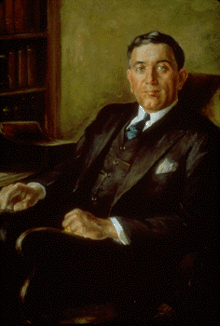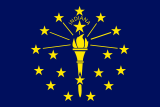- M. Clifford Townsend
-
Maurice Clifford Townsend 
35th Governor of Indiana In office
January 11, 1937 – January 13, 1941Lieutenant Henry F. Schricker Preceded by Paul V. McNutt Succeeded by Henry F. Schricker 31st Lieutenant Governor of Indiana In office
January 9, 1933 – January 13, 1937Governor Paul V. McNutt Preceded by Edgar D. Bush Succeeded by Henry F. Schricker Member of the Indiana House of Representatives In office
1925–1929Personal details Born August 11, 1884
Blackford County, IndianaDied November 11, 1954 (aged 70)
Hartford City, IndianaSpouse(s) Nora Adele Harris[1] Alma mater Marion College Religion Methodist[1] Maurice Clifford Townsend (1884–1954) was the 35th Governor of the U.S. state of Indiana from 1937 to 1941. During his term he led relief efforts during and after the Great Flood of 1937.
Contents
Early life
Maurice Clifford Townsend, known as Clifford to his friends and family, was born on a farm in Blackford County, Indiana to David and Lydia GlancyTownsend on August 11, 1884. He had one sister, Myrtle, and the two were raised on a country farm. After completing high school in 1901 he worked as a teamster in the oil fields during the Indiana Gas Boom, and later in a factory. In 1907 he entered Marion College in Grant County. After working as a teacher for six years to pay for his education, he graduated in 1907. He then taught in the common schools, and served as school superintendent for different counties between 1909 and 1919.[2]
He entered politics as a representative in the Indiana House in 1923. His single term in the legislature was focused mostly on reforming the state's tax code, an issue he worked on up through his term as governor. In 1928 he ran an unsuccessful campaign for Congress, but was defeated. He then returned to education, serving again as a school superintendent and on the executive committee of the Indiana's Teachers Association in 1929. Townsend's experience in education made him Paul V. McNutt consider him as a candidate for Lieutenant Governor and helped him to win the nomination at the state's Democratic convention in 1932.[3]
He was elected the 31st Lieutenant Governor on the Democratic ticket and served from 1933 until 1937. The position of Lieutenant Governor was dramatically altered during his term. Previously, the position received only a token salary, only required active work during legislative sessions, which amounted to sixty days every two years. The position was granted significantly more power after the passage of the 1932 Executive Reorganization Act when the position was made head of the state's agricultural department and assigning him other administrative duties. The change put a large number of patronage jobs under his control.[3]
Governor
Townsend's mother placed his name in nomination for governor at the 1936 Democratic state convention. His nomination though, was a tough battle. The Democratic Party was split between three strong faction, with McNutt supporting Townsend, powerful senator Sherman Minton supporting Pleas Greenlee, and the chairman of the state party supporting Kirk McKinney. The fight at the convention was bitter, and a fist fight broke out before the final vote took place. In the end McNutt's control over the party machine determine the nomination in favor of Townsend.[4] The popular McNutt campaigned heavily on Townsend's behalf in the general election. Republicans again made gains in the General Assembly, but Democrat kept the majority and Townsend won the election, defeating Republican Raymond Springer by over 180,000 votes.[5]
Townsend was inaugurated January 11, 1937. The state was immediately beset with a disaster as the Great Flood of 1937 began. Within a week, every community on the Ohio River was destroyed and hundreds of thousands were homeless. In the early stages, he coordinated evacuation efforts, routing all available trains to carry people to safety as flood waters rose. Thousand of relief workers and the national guard were called out to help rebuild. The disaster remains the second worse to have ever hit the state. Indiana was the only state affected by the flood, and there were no drownings reported. Harry L. Hopkins of the National Relief Administration said, "No state was better managed during the flood than Indiana."[5]
Before the flood relief was completed, a large strike broke out in General Motor factories across the state. Violence broke out in Anderson and the National Guard was called out by Townsend to restore order and protect the factory. The strike prompted Townsend to request the creation of the state Division of Labor to provide voluntary mediation in union strikes. Steel workers in Gary launched a strike in 1937, and the division successfully prevented it from turning violent.[5]
As the end of his term neared, the former state party chairman Frank Van Nuys, who had been elected Senator again, attempted take control of the party from the McNutt-Townsend faction. The battle was primarily over who would control federal patronage jobs. President Franklin Roosevelt intervened after Van Nuys opposed his plan to stack the United States Supreme Court, and used his own influence to have Van Nuys defeated in his reelection bid. Townsend at first agreed to go along with Roosevelt's plan, but after McNutt decided it would be to harmful to the state party, Townsend changed his mind, much to Roosevelt's chagrin.[6]
In the mid-term elections, Republican took the control of the Indiana House of Representatives, 51 to 49. The Republicans blocked Townsend's proposed new social programs, and attempted to roll back many of his predecessor's programs. The Senate blocked the bills from passage, and the session ended in deadlock. Only a few pieces of legislation were passed: the driver's license examination became required by law, pensions for the state's firemen were approved, free textbooks were authorized for public schools and the state ordered school buses to be painted yellow for safety's sake—this last starting a nationwide trend.[7]
Later life
After Townsend left office, he extricated himself from internal politics of the state party, and did not involve himself in the selection of his successor. During World War II Townsend used his farm experience in government service, directing the Office of Agricultural War Relations, the Agricultural Conservation and Adjustment Administration, and the Food Production Administration. In 1943 he resigned from federal service and returned to Indiana to manage his farms in Blackford and Grant counties. Townsend was the Democratic nominee for the United States Senate in 1946, but was defeated by William E. Jenner.[7] He died November 11, 1954 from a heart attack, and was buried at the Odd Fellows Cemetery in Hartford City, Indiana.[7]
See also
References
Notes
Bibliography
- Gugin, Linda C. & St. Clair, James E, ed (2006). The Governors of Indiana. Indianapolis, Indiana: Indiana Historical Society Press. ISBN 0871951967.
External links
- Indiana Historical Bureau: Biography and portrait
- Find-A-Grave biography
- National Governors Association
- Indiana County History - Townsend Biography
Political offices Preceded by
Edgar D. BushLieutenant Governor of Indiana
January 9, 1933 - January 13, 1937Succeeded by
Henry F. SchrickerPreceded by
Paul V. McNuttGovernor of Indiana
January 11, 1937 - January 13, 1941Succeeded by
Henry F. SchrickerLieutenant Governor of Indiana  Harrison · Boon · Thompson · Stapp · Wallace · Hillis · Hall · Bright · Dunning · Lane · Willard · Hammond · Morton · Baker · Cumback · Sexton · Gray · Hanna · Manson · Chase · Nye · Haggard · Gilbert · Miler · Hall · O'Neill · Bush · Brunch • Van Orman • Bush • Townsend · Schricker · Dawson · James · Alexander · Watkins · Handley · Parker · Ristine · Rock • Folz · Orr · Mutz · O'Bannon · Kernan · Davis · Skillman
Harrison · Boon · Thompson · Stapp · Wallace · Hillis · Hall · Bright · Dunning · Lane · Willard · Hammond · Morton · Baker · Cumback · Sexton · Gray · Hanna · Manson · Chase · Nye · Haggard · Gilbert · Miler · Hall · O'Neill · Bush · Brunch • Van Orman • Bush • Townsend · Schricker · Dawson · James · Alexander · Watkins · Handley · Parker · Ristine · Rock • Folz · Orr · Mutz · O'Bannon · Kernan · Davis · SkillmanGovernors of Indiana 
Territorial (1800–1816) 
State (since 1816) Jennings · Boon · W. Hendricks · Ray · Noble · Wallace · Bigger · J. Whitcomb · Dunning · Wright · Willard · Hammond · Lane · Morton · Baker · T. Hendricks · Williams · Gray · Porter · Gray · Hovey · Chase · Matthews · Mount · Durbin · Hanly · Marshall · Ralston · Goodrich · McCray · Branch · Jackson · Leslie · McNutt · Townsend · Schricker · Gates · Schricker · Craig · Handley · Welsh · Branigin · E. Whitcomb · Bowen · Orr · Bayh · O'Bannon · Kernan · DanielsCategories:- 1884 births
- 1954 deaths
- Governors of Indiana
- Indiana Democrats
- American Methodists
Wikimedia Foundation. 2010.
